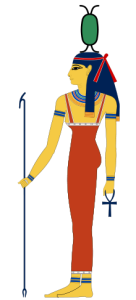Athena
Neith
Neith was an ancient Egyptian goddess and patron god of Sais, where Solon is said to have learned about Atlantis. Neith is often identified with the Greek goddess Athena as well as the Berber and Punic goddess Tanith (Tanit, Tanut), although this has been disputed(a). Tanith is said to be derived from the Phoenician lunar goddess and claims have been made that Tanit was also a Hyksos goddess.
>A paper(e) outlining the appearance of Tanit on Iberian coins of villages that had been in contact with the Phoenicians can be read on the Academia.edu website.
Some years ago Egerton Sykes noted in his Atlantis magazine “that the Egyptian goddess Neith (NTH) was the same as Tanith (TNH) and Athene (THN), the letters in brackets being the Egyptian consonants for the names.”(d)
<
The association of Greek with Egyptian deities was originally told to us by Herodotus(b). A similar connection between Greek and Hindu gods has also been identified(c).
(a) See: https://web.archive.org/web/20170326111445/https://www.mlahanas.de/Greeks/Mythology/Athena.html
(b) See: Archive 2574
(c) https://www.integralworld.net/augustine21.html
(d) Atlantis AT142 p47 *
(e) https://www.academia.edu/38716450/Cult_and_dedication_to_Tanit_in_the_Iberian_coins *
Parthenon
The Parthenon atop the Acropolis of Athens is one of the best-known monuments in the world. In its glory days, it must have been even more impressive as it is now known that the edifice was painted in ‘dazzling’ colours(e). When it was first realised that the Greeks and Romans had made such an extensive use of colour on their statuary and buildings it must have come as a shock to many. However, the painting of statues may have a very ancient history as a recent discovery at Karahan Tepe, a life-size statue of a wild boar, dated to between 8700 BC and 8200 BC, has demonstrated, where “Archaeologists detected red, black and white pigments on its surface, indicating that the sculpture was once painted.” (i)
It has been long claimed that the Parthenon incorporated the Golden Ratio (1:1.618) in its design(b). This is now strongly refuted by Chris Budd OBE, Professor of Applied Mathematics at the University of Bath(c) and Samuel Arbesman a senior scholar at the Ewing Marion Kauffman Foundation(d).
The Parthenon was claimed by David Pinnegar(a) to have been constructed to commemorate the victory of the Athenians over the Atlanteans. He further contends that the frieze that adorned the Parthenon holds a representation of the debate to which Plato referred at the end of the Critias text. If this interpretation is true, is it not likely that Plato or any other classical writer would have referred to it? The frieze also appears to depict the Athenian war with the Amazons.
>In 2004, Robert Bowie Johnson jr, published The Parthenon Code [2078], in which the author claims “that both the Book of Genesis and the artwork found on the Parthenon are telling the same story — but from a reversed perspective. He writes that Genesis tells the story of the submissive, “the line of Seth.” The Parthenon, meanwhile, tells the story of those who resist the God of the Bible, the “line of Cain,” (spelled “Kain” in some non-biblical material).
The author compares the art found on ancient Greek vases with the statuary found on the Parthenon, and discerns a detailed story of the Greek gods and their resistance to and struggle against the God of the Bible. A common, unambiguous story, opposite from that told in Scripture, is detected when that evaluation is made. It is a story in which the God of Noah — the God of Seth — is actually defeated by the Greek gods!”<
In 2008, Evan Hadingham wrote an article for Smithsonian Magazine reporting on behind-the-scenes discoveries at the Parthenon encountered during the current extensive restoration work there(g). A 2021 article in the same magazine has drawn attention to controversies that have arisen over details of the renovation work(h).
A full-scale copy of the Parthenon was constructed in 1897 in Nashville, Tennessee to celebrate the state’s centennial(f). Inside is the tallest (over 41ft) indoor sculpture in the Western world, depicting a stunning gold-covered image of Athena.
(a) http://www.hammerwood.mistral.co.uk/elgin.htm
(d) Math as Myth – Nautilus | Science Connected (archive.org)
(e) https://www.bbc.com/culture/article/20180119-when-the-parthenon-had-dazzling-colours
(f) https://www.nashvilleparthenon.com
(g) https://www.smithsonianmag.com/history/unlocking-mysteries-of-the-parthenon-16621015/
(i) 11,000-year-old statue of giant man clutching penis unearthed in Turkey | Live Science

